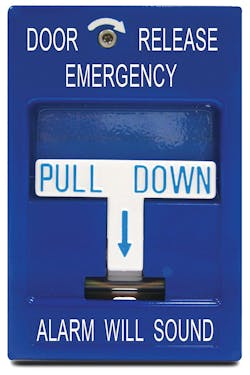Fire & Life Safety: Request to Exit Compliance
A six-year-old fire alarm system installed by one of my readers was recently inspected by the local fire department. The building owner was told that the request-to-exit buttons on six exit doors needed to be replaced with pushbuttons that light up. The old ones were blue die-cast metal “Emergency Door Release” pull-boxes with a T-bar handle imprinted with an arrow and the words “Pull Down.”
The fire alarm system was approved initially, as well as every year since then by the local fire safety inspectors. The reader asks how the fire department can decide something is non-compliant after approving it for six years.
To answer, it appears there are two code issues at stake. The first involves a fire inspector asking for an update or change where no new work or change of occupancy has put the system back into play. If equipment is approved by the inspectors initially, and a year or more has passed, they are hard-pressed to suddenly disapprove the item.
The second issue is the strict enforcement of the letter of the law. The applicable requirement from the Building/Fire Code section 1008.1.4.4 “Access-Controlled Egress Doors” only applies to entrance/exit doors controlled (allowing and not allowing the exit to open for egress).
In other words, if the door hardware enables the door to be used from the inside – at any time and by anyone – to get out, then that section of the code does not apply.
Mechanical retracting latch doors do not control exit use, and thus do not fall under this rule. Even if an electric strike is used, it is not access-controlling the egress door.
On the other hand, if an electro-magnetic brick keeps the egress door secured, this section would apply. Any locking arrangement that prevents the exit door from opening from the inside to allow egress during business hours or when the building is open to the public is very much covered by the code.
Here’s a summary of IBC/IFC section 1008.1.4.4, “Access-controlled egress doors,” which addresses entrance doors in a means of egress:
- Outer entrance doors and entrance doors to tenant spaces in specified occupancies (A, B, E, I-2, R-1 or R-2) are permitted to be equipped with an approved entrance and egress access control system.
- As part of the approved access control system, an egress sensor that detects someone approaching and unlocks the doors must be included on the egress side. The door must also unlock upon loss of power to the sensor or door locks.
- A manual unlocking device located 40 to 48 inches vertically above the floor and within five feet of the secured doors must be included and clearly identified by a PUSH TO EXIT sign. Using the manual unlocking device results in direct interruption of power to the lock – independent of the access control system electronics, and the doors shall remain unlocked for a minimum of 30 seconds.
- The doors must unlock if the fire alarm, sprinkler or fire detection system is activated, and remain unlocked until the fire alarm system is reset.
- Finally, entrance doors in occupancies A, B, E and M may not be locked from the egress side when the building is open to the public.
The blue exit release boxes installed at this site meet the requirements of the code noted above. Just because the devices have a pull-down handle instead of a pushbutton is not a factor; in fact, the use of a pushbutton is only implied. Where the ICC could have stated a pushbutton shall be used, the code only states it must be a manual unlocking device – it then goes on to use the term “device” instead of “button” three more times.
The requirement of a PUSH TO EXIT sign is what suddenly caught the inspector’s attention. Maybe this inspector recently attended a code update class and this issue was brought to the forefront.
The existing pull-boxes are actually more of a deterrent than a pushbutton would be. It takes a commitment from someone to pull a handle and break a glass rod; on the other hand, it takes much less nerve (impulse control) to push (accidently lean against) a big button.
When responding to the inspector and/or a written citation, I would tactfully give the inspector an out. Show them Chapter One of the Fire Code, section 104.11, where they have been given discretion to give the thumbs up to any “design or method of construction [that] is satisfactory and complies with the intent and provisions of this code” as below:
“The provisions of this code are not intended to prevent the installation of any material or to prohibit any design or method of construction not specifically prescribed by this code, provided that any such alternative has been approved. An alternative material, design or method of construction shall be approved where the building official finds that the proposed design is satisfactory and complies with the intent of the provisions of this code, and that the material, method or work offered is, for the purpose intended, at least the equivalent of that prescribed in this code in quality, strength, effectiveness, fire resistance, durability and safety.”
Of all the above counterpoints, the first sentence in section 104.11 should do it. If nothing else, the installation clearly has existing, approved equipment that meets OBC/OFC 104.11.
Wildfire Worries
Perhaps you are aware of the wild forest fires in recent years – mostly in our western states. While the issue of property loss/damage is not my primary focus, the safety of lives is of grave concern.
A reader recently asked: “We have a high fire danger weather alert on the news – this is a common occurrence and it seems we are headed for a very dry summer. Are there any systems available that could be put on the perimeter of a property to alert the homeowners that a fire is near in the event they do not smell the smoke?”
I am interested about the various methods readers may have used to address this growing safety concern. Please email me at [email protected], or contact SD&I Editor in Chief Paul Rothman ([email protected]) with details – both successes and failures – of any installations you have tried. I will share them in a future column.
Greg Kessinger ([email protected]) has been SD&I’s fire alarm and codes expert and a regular contributor for more than 15 years.



